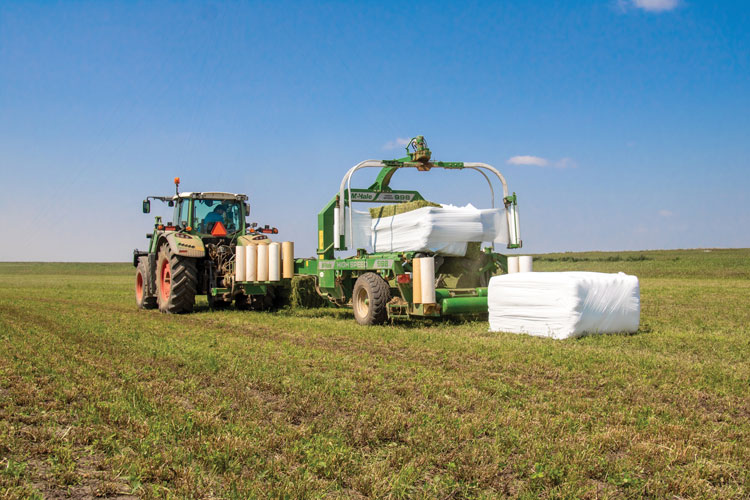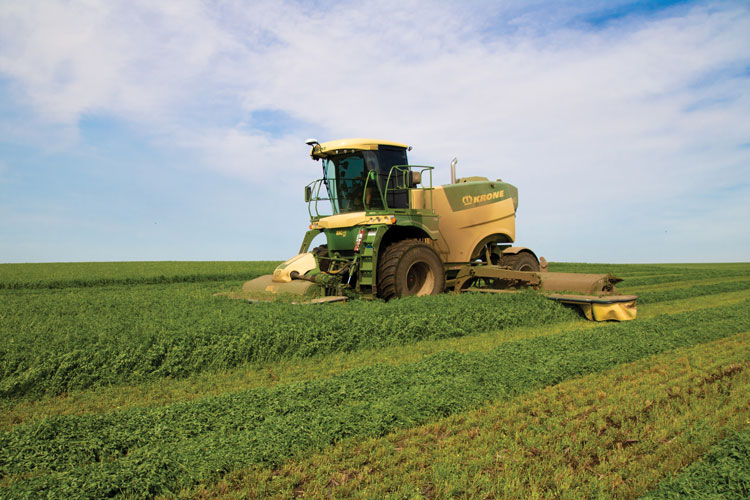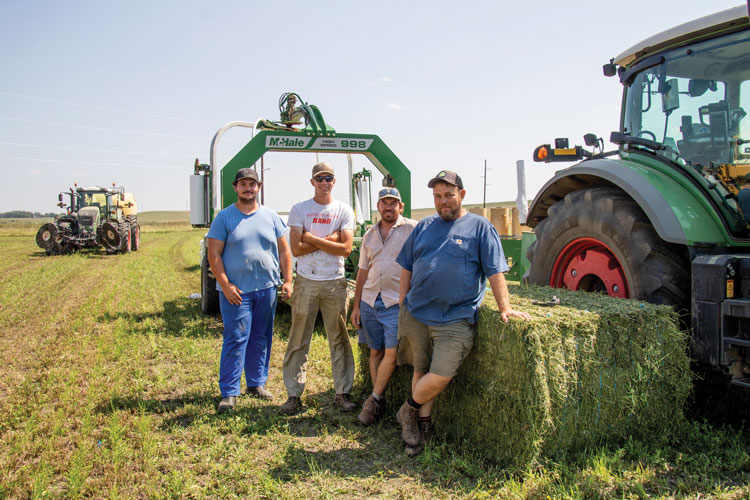
On a Tuesday afternoon in the middle of August, Dan Funke zipped through a hayfield in a Krone Big M450 triple mower. He was taking the third cutting of a spring seeding of alfalfa alongside John Schruers, a full-time employee, who was driving another piece of the same machinery. The two men cut 150 acres of alfalfa in a little over an hour — a fast-paced farming activity that Funke almost forgot what it was like to be a part of.
“This is fun for me,” he said. “I don’t usually get to run the mower.”
Instead, Funke spends most of his time in the driver’s seat of a Krone 1290 high-density press 3x4 large square baler. The forage producer from Larchwood, Iowa, grows about 1,100 acres of alfalfa in the northwest corner of the Hawkeye State, making baleage and delivering it to local dairies. Funke hasn’t always been in the baleage business, though. The first-generation farmer started out making dry hay.
Although Funke didn’t grow up on a farm, he worked on one when he was in high school to put himself through college. The experience inspired him to have a career in agriculture, and he eventually bought a round baler and started doing custom work. Over time, he rented some farmland and began growing forage of his own, which evolved into his primary enterprise. Funke thought hay had more profit potential than row crops, but hitting target moisture levels before baling proved to be his biggest challenge.
“I really focused heavily on trying to get my hay dry,” Funke said. “For seven or eight years, I tried to crimp the heck out of it, rake it, tedder it. At the end of the day, I was only making dairy-quality feed about 20% of the time. You can’t win by doing that.”
In hopes of breaking his so-called losing streak, Funke decided to try making baleage. He spoke to other adopters of the high-moisture forage and bought a square baler and an individual bale wrapper to put his idea into action. Today, Funke bales and wraps all of his alfalfa, and he and his customers are more than pleased with his consistently high forage quality.

Committed to cutting
Funke aims to make baleage with 200 relative feed quality (RFQ) or higher, so harvest timing is his top priority. He has a “no flower policy” in his hayfields and takes five cuttings of alfalfa per year in most established stands. He makes note of cutting dates and keeps an eye on the calendar to harvest forage every 23 to 24 days, rarely letting an interval last longer than 28 days.
Alfalfa is typically no-till drilled in the spring into oats or cereal rye that were planted as a cover crops the previous fall. Stands usually last three years after the seeding year before Funke rotates the field with corn, soybeans, or annual warm-season forages. Then the cycle begins again.
Depending on when first cutting takes place, Funke makes fifth cutting from mid-September to mid-October. Some producers avoid harvest during this critical fall period to ensure forage has enough time to store energy in its roots before a killing freeze, but Funke is willing to risk overwintering issues if it means he can make more high-quality baleage. And even though older alfalfa stands are more vulnerable to winterkill, he isn’t afraid to be flexible with these fields.
“If there is a harvestable crop that I think I can get close to 1 ton per acre, I take it,” Funke said. “If I have three good years out of an alfalfa stand and I take a cutting that beats it up, I will just plant something else in the spring. Second- and third-year hay is where it is at. After that, it’s often time to start over anyway.”
Funke has started experimenting with seeding sorghum-sudangrass hybrids after terminating alfalfa in the spring. He planted a photoperiod-sensitive hybrid of the warm-season annual in June 2023, as well as a quarter section of sorghum-sudangrass with the brachytic trait. He was disappointed by the extremely dry start to the growing season that limited plant growth and forage yield, but some late summer rains seemed to improve subsequent cuttings. That said, Funke is eager to try incorporating this species into his forage system again, especially since his dairy customers have shown an increasing interest in sorghum-sudangrass baleage as an excellent source of highly digestible fiber.
“We are going to keep heading down the road to finding a forage program where we can grow high-energy grass crop,” he said. “We have our alfalfa program pretty solid, and I am happy with where that is at. The next thing to focus on will be summer annuals.”
Baler upgrades
Following harvest timing, Funke said proper baling and wrapping are the second-most important aspects of his operation. His first standard density square baler did not have a precutter, but he quickly learned this feature was essential to make baleage for dairy farmers who would be adding the high-moisture forage into mixed rations. Plus, precutting alfalfa seemed to make the bale wrapping process a smoother one.
His next equipment upgrade was to a high-density baler, which he figured would help maximize his input costs. “I thought if I put the same dollars’ worth of plastic on each bale, no matter how much was in them, I could make fewer bales with a high-density baler and cut my plastic costs,” Funke said. “When I traded for a high-density baler with a precut system, it increased my dry matter per bale by 20%.”
Funke’s most recent trade-in was for his Krone 1290 high-density press baler, which takes the benefits of a high-density baler to another level with nearly double the capacity of his previous model. Of course, this requires about two times the horsepower of his previous machine, but Funke makes even fewer bales that are packed even tighter — about 25 pounds per square foot. He believes this is key to be able to preserve bales at 20% to 50% moisture, and he aims for the lower end of that range, making a product on the dry end of the baleage spectrum that is also known as sweet hay.
“Some people will tell you to wrap bales at 40% moisture or higher to get proper fermentation and to use an inoculant to make storable feed. I think if you can pack bales tight enough, none of that matters,” Funke said. “We are making better feed because we can stomp every last bit of oxygen out of the bales.”
Funke has one stationary Goweil Q4020 bale wrapper and two McHale 998 bale wrappers that can be pulled around the field. These machines, as well as his mowers and four Oxbo mergers, are usually operated by Schruers and Funke’s staff of seasonal employees, which included Henry Wright, Joubert Greeff, and Andreas Lombard in the summer of 2023.
Help from H-2A hires
While Wright is from the nearby town of Brandon, S.D., and works for Funke when he is home from college, Greeff and Lombard are from halfway around the globe. The two men came to the United States from South Africa through our nation’s H-2A program, which was created to help farmers secure seasonal labor by hiring foreign workers. Funke had to complete extensive paperwork before being accepted to the program, and once he was matched with Greeff and Lombard, they arrived at his farm on April 1.
One requirement of the H-2A program is that seasonal employees must return to their home countries for a designated amount of time every year. Greeff and Lombard were hired to work full time through the summer and fall before going back to South Africa in early December. Despite a round-trip ticket that involves immense travel, it is quite feasible for South Africans to work in the United States during this time because the two nations have opposite growing seasons. When Greeff and Lombard were in Larchwood, it was winter back home.
The two men initially faced a few learning curves driving mowers, mergers, and bale wrappers, but Funke said they caught on quickly. He added that they showed impeccable work ethic and are always eager to be in the field.
“Having H-2A workers is the best thing, especially because these guys come here and they want to work,” Funke said. “My biggest problem is when it’s raining and I tell them to go home, but they just want to keep working,” he chuckled.
Funke used to employ more high school and college students to work for him in the summer, but their availability would end abruptly once classes resumed in August. Although he was always happy with those hires, the H-2A program better supports his employment needs.
While he must provide foreign workers with housing and at least one vehicle to share, the H-2A program does not require employers to provide food for their employees; however, Funke often does anyway. In fact, each member of the crew shuts down their engines around noon to meet on the tailgate of their trucks or around a dining table in Funke’s shop to share a midday meal.
“We have lunch together every day,” Funke said. “It’s good because we are always hungry by then, but also so we can sit down and talk about our plan for the rest of the afternoon.”

A personal investment
In addition to making hay on his own acres, Funke does some custom forage harvesting. He and his crew harvest about 1,000 acres of forage per cutting between a few clients and then take on smaller tasks here and there. These jobs are not the bread and butter of his farming business, but they have helped him justify investments in more advanced equipment.
“I like to keep my baler fresh, so it gets traded once every three years,” Funke said. “And if I didn’t do custom work, I wouldn’t have those two very expensive machines,” he said pointing to the mowers.
What kickstarted his farming career is now more of a source of diversified income, which is a testament to his progression from a first-generation farmhand to a high-quality forage producer. Funke has applied this experience off the farm as an active member of the Midwest Forage Association, serving as an at-large producer on the organization’s board of directors for 12 years. Being in this position has allowed him to make many connections with other producers across the country and taken him to the nation’s capital to speak with policymakers and advocate for the forage industry. Although his alfalfa stands out among all of the row crops in northwest Iowa, becoming a baleage maker has expanded Funke’s involvement and influence in the world of agriculture well beyond the hayfield.
“Instead of starting at the 30-yard line, I started way back in my own end zone. But I don’t think I would have thrived, or even survived, in any other enterprise,” Funke said. “Forage production has allowed for that. This business is full of opportunities.”
This article appeared in the November 2023 issue of Hay & Forage Grower on pages 26-28.
Not a subscriber? Click to get the print magazine.

